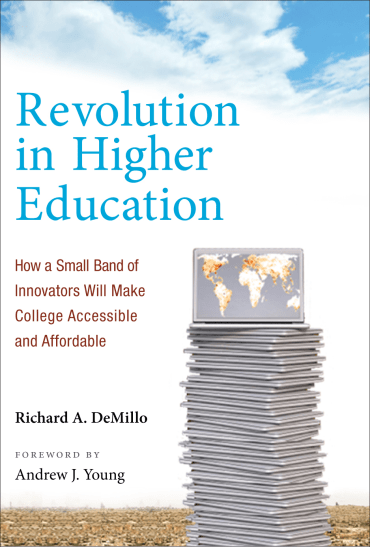
Big Data allows higher education leaders to both see and create an environment where they’re able to meet—and even anticipate—the broad and unique needs of their students at scale.

Big Data allows higher education leaders to both see and create an environment where they’re able to meet—and even anticipate—the broad and unique needs of their students at scale.

I’m happy to announce that the paperback edition of Revolution in Higher Education has just been released by MIT Press. It is available from online and traditional booksellers everywhere.

Judging from recent books, articles, and editorials, higher education is poised for a cataclysmic collapse. There is a considerable body of opinion that systemic problems such as runaway tuition, student debt, low graduation rates and pervasive elitism are so wired into the collective culture of college faculty and administrators that only drastic and disruptive measures can break through institutional logjams.
In fact, this list barely scratches the surface.
On the other hand, it is hard to see a looming cliff. Portraying the university as an enterprise immune to change (at best) or actively hostile to it (at worst) is wildly inaccurate and misstates the actual pace of change.
At the start of a new year—and a new administration in Washington whose post-secondary agenda is unknown—it is worthwhile to take stock of the accelerating innovation in higher education.
Systemic problems often demand structural solutions. Five years ago, I was tapped to lead an internal think tank devoted to fundamental change in higher education, Georgia Tech’s Center for 21st Century Universities. My job is to anticipate the kind of disruptive forces that would have structural repercussions for research universities like Georgia Tech.
Crafting an agenda for change from within a university presents unique challenges, including the complex task of declaring victory. Many of the current issues in higher education seem to require new players, markets, or external agents of change. Yet, I’m convinced that it is equally promising to seek renewal from within.
Read more at The James G. Martin Center for Academic Renewal.
Today’s #FutureHigherEd idea is a novel use of big data to match students with peers and mentors and improve the learning experience. In 2010, Tim Renick at Georgia State Univesity started to examine millions of student grade reports looking for markers that might be predictive of classroom success. Over time, Renick and his team developed analytical models that would alert students and advisors when an intervention is needed. The resulting data-driven interventions improved graduation rates and saved GSU students over $3 Million in tuition payments. It also saved the university money and those savings justified hiring more advisors. The GSU project helped launch a revolution in the use of data to improve outcomes and was the subject of an Education Advisory Board case study which can be found here.
Terry Hosler’s submission to the openIDEO Challenge takes this idea in another direction: using student data to match students with peers and mentors. It’s an important concept because this kind of support strongly influences achievement.
For a student to be successful attending a university or college away from home takes a ‘village of support’ including guiding communication both before and once arriving on campus with both the student and their network of support (family, mentors, and, when the student chooses, a broader community to increase their confidence and comfort level.
This need is there for all students out of their normal cultural environment.
This cultural match is particularly crucial for low-income, first-generation, rural students who are academically astute but unsure of higher education opportunities ‘away from home’ due to lack of experiences and feeling ‘like a fish out of water’.
https://challenges.openideo.com/challenge/future-of-highered/research/looking-back-and-looking-forward (Tyler’s Story)
How can Hosler’s idea be combined with the GSU predictive analytics model to identify not only culturally similar peers, but also a community of mentors and tutors who are likely to be effective at helping students improve classroom performance?

Prof. Dan Ryan from Mills College posted another thoughtful piece on #FutureHigherEd, posing the question what will the regulation of academic quality look like in a Flat World?
We can imagine the emergence of both disruptive skill/knowledge certifying enterprises that operate at the individual level and certification accrediting enterprises that operate at the program level. To generate a healthy ecosystem of such “regulators” we will need to think not in terms of government regulation of educational institutions but rather of some collective regulation of regulators.
Ryan has in mind a collection of marketplace solutions that together will: :
In short, these are reforms that should foster innovation. It was the first thing that occurred to me in 2012 when the MOOC phenomenon started to reshape my thinking about technology-enabled learning:
Letting learning outcomes speak for themselves in a Linked-In network of referrals, accrediting course repositories rather than institutions, and crowd-sourcing ratings to help students choose among competing courses and curricula are all experiments that are under way. Whatever their outcome, the future of accreditation will not be the same.
I was pretty critical of accrediting agencies back then, but over the past four years I have found myself returning over and over again to the idea that the same Flat World rules that inspired Dan Ryan can also breathe some new life into this necessary part of education:
Accreditation is, well, boring. Accreditors are the green eye shade players in the drama of higher education. It’s hard to get excited about green eye shades, but today—improbably—I find myself excited by accreditation. To be more exact, I am excited about what will replace it.